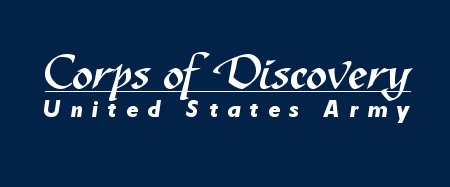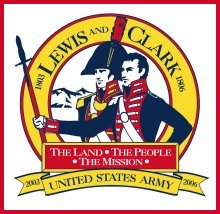Members of the Expedition
Non-Commissioned Officers
Sergeant Charles Floyd (1782-1804)
Kentucky
One of the "Nine Young Men from Kentucky," Floyd was made
a sergeant before the expedition began. Lewis regarded him as "a
young man of much merit." Floyd is remembered principally as the
only member of the Corps of Discovery lost on the journey. He died on
August 20, 1804, near present-day Sioux City, Iowa, probably from what
modern medical experts believed was a ruptured appendix. Floyd kept
a journal until a few days before his death.
Sergeant Patrick Gass (1771-1870)
Pennsylvania
First Infantry
Recruited at Fort Kaskaskia from Captain Russell Bissell's company
of the First Infantry, Gass had joined the Army in 1799 after serving
in a volunteer Ranger unit. His skill as a carpenter was of great value
to the expedition. Gass was promoted to sergeant In August 1804, following
the death of Floyd. In 1807, Gass was the first to publish his journal.
He stayed in the Army and served in the War of 1812, but was discharged
after losing an eye in an accident. Gass is the last known survivor
of the expedition.
Sergeant John Ordway (1775-1817)
New Hampshire
First Infantry
The only sergeant in the Army before the expedition, Ordway was recruited
at Fort Kaskaskia from Captain Russell Bissell's company of the First
Infantry. He was well educated and became the senior sergeant of the
expedition. He took care of the daily administration and, in the absence
of the two captains, was in charge of the expedition. Ordway was the
only member of the Corps of Discovery to keep his journal faithfully
throughout the expedition. His accounts of Indian life are invaluable.
Sergeant Nathaniel Pryor (1772-1831)
Virginia / Kentucky
Pryor was a widower and cousin of Charles Floyd. Pryor was one of the
"Nine Young Men from Kentucky." Lewis and Clark considered
him to be "a man of character and ability," and after the
expedition helped him secure an officer's commission in the Army. Pryor
rose to the rank of captain and participated in the Battle of New Orleans
in 1814. He later served as a government agent for the Osage Indians
in 1830-31.
Corporal Richard Warfington (1777 - ?)
North Carolina
Second Infantry
Transferred from Captain John Campbell's company of the Second Infantry
Regiment as a corporal, Warfington was both reliable and efficient.
When his enlistment expired during the expedition, Lewis and Clark asked
him not to take his official discharge, but to retain his rank and authority
and command the return party to St. Louis in 1805. The captains believed
Warfington was the only trustworthy member of the return party, and
wanted to ensure the safety of their dispatches, journals, and specimens
sent to President Jefferson. Warfington accepted command of the return
party and completed his mission so successfully that he even managed
to keep alive a prairie dog and four magpies Lewis had sent to Jefferson.
Lewis later recommended Warfington receive a bonus beyond his regular
pay.





